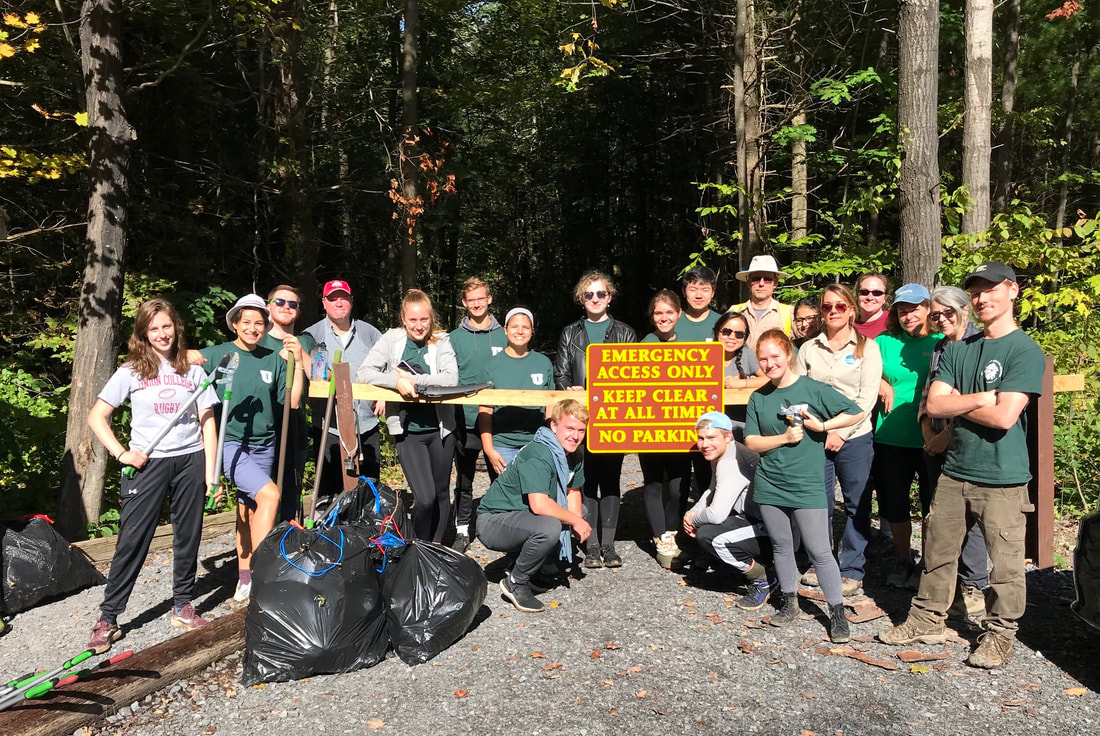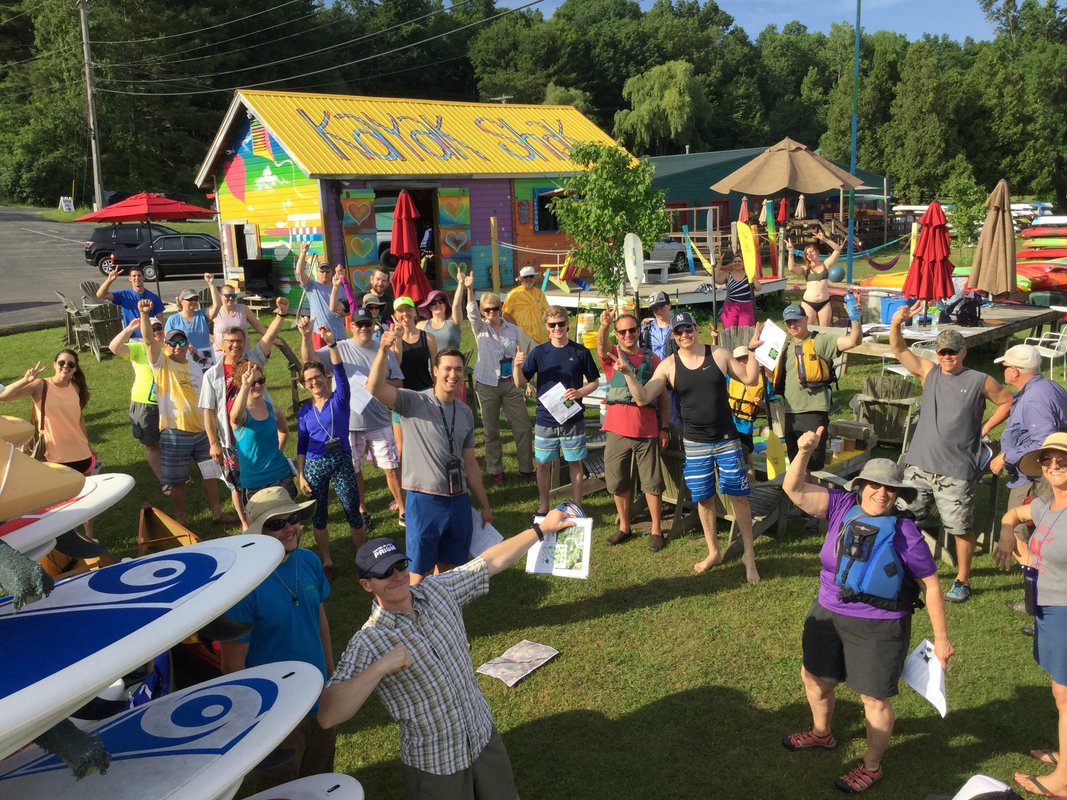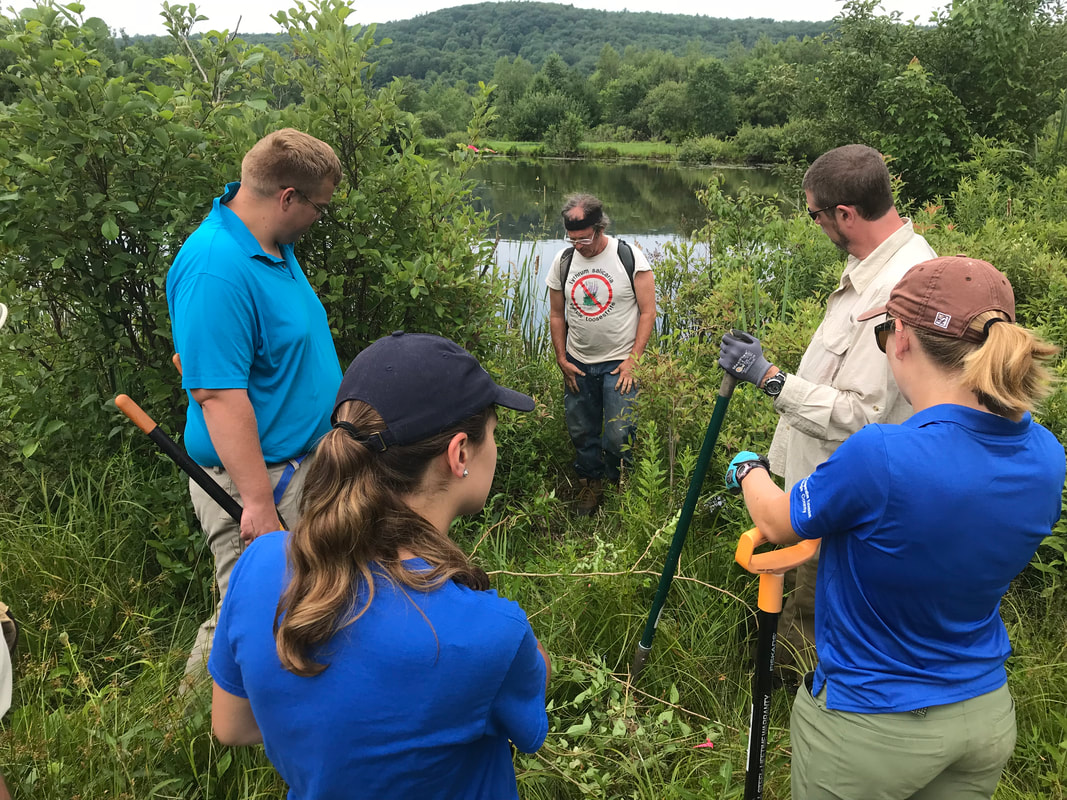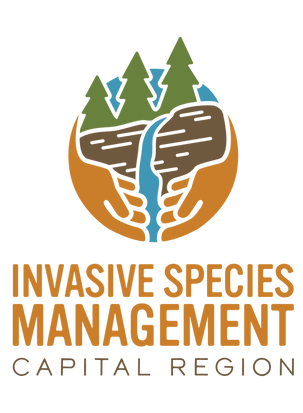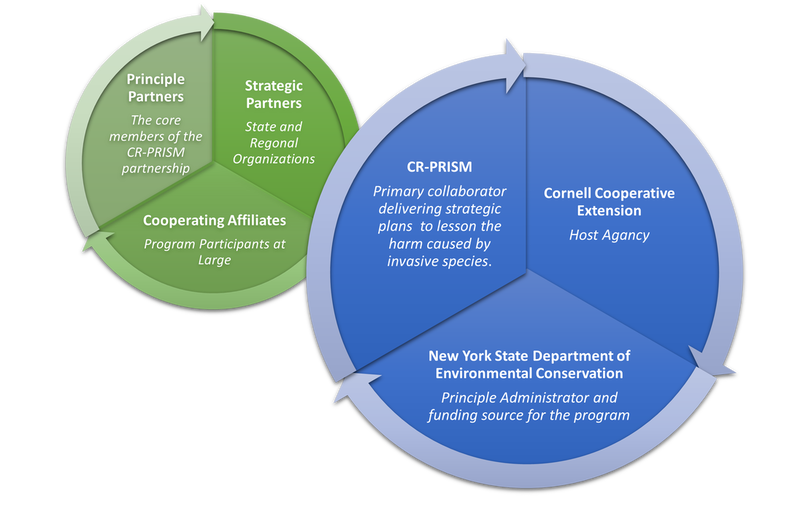
Capital Region PRISM and the Partnership
Partners are an integral component of the CR-PRISM in reaching a common goal of slowing and controlling the spread of invasive species. An essential task of the PRISM is to identify and assist stakeholders to improve opportunities for sharing of resources while delivering up-to-date practices for prevention and management. Collaborating with partners on projects, programs, and events while sharing resources, data, and research saves time and effort. Continually increasing partner capacity is one of the keys to the success of the PRISM and slowing the spread of invasive species on a regional scale.
To learn more on how to partnering with the Capital Region PRISM please review our Partner Invite and Acknowledgment Form and contact a coordinator.
Partners Defined
Partners are public agencies or private organizations actively working to achieve outcomes on the ground to minimize the impact of invasive species on the greater capital regions communities, lands, and waters. The Partnership consists of any organization, volunteer, or community member that has an interest in the CR-PRISM’s mission and shared vision.
The CR-PRISM welcomes partner members from academic institutions, government agencies, municipalities, not-for-profit organizations, private preserves and parks, land trusts, conservancies, lake associations, agricultural institutions, local businesses, environmental groups, tribal groups, community scientists, and other clubs or organizations to join the partnership. Individuals can also serve to assist the PRISM. Partners can also include subcontractors operating under agreements as implemented through a request for proposals, competitive or sole sourced contracts, and memorandums of understanding.
CR-PRISM Partner Classifications
For organizational purposes our partnership has three classifications:
1. Principal Partners are those organizations with the greatest vested interests with the mission of the CR-PRISM. Principal Partners are critical to the delivery of components of the CR-PRISM Five Year Strategic Plan and engage with the CR-PRISM staff on a regular basis. Principle Partners
Strategic Partners
The CR-PRISM also acknowledges the ancestral stewards of the lands and waters in which we help to protect, the Mohican and Mohawk people. The CR-PRISMs commitment to preserving the natural resources of our shared environment, honors the legacy of the Mohican and Mohawk peoples, as the original stewards who nurtured this land as an indigenous population. We honor and respect their historic dedication to taking care of the natural world and commit our efforts to making these lands a more inclusive and equitable environment for all.
Partnership Benefits:
The individual contribution of each partner is magnified by its engagement in the CR-PRISM. Partners receive many benefits by joining in the collective efforts of the CR-PRISM. The greatest benefit is through the power of collaboration and an increase in capacity to conduct invasive species prevention, monitoring, response, and restoration and research efforts to benefit conservation actions.
Networking and Collaboration
CR-PRISM partner meetings and events provide an opportunity to engage with other organizations and individuals committed to minimizing the impact of invasive species. The networking opportunities in these meetings and events allow for sharing ideas and knowledge about natural resource management practices, exploring ways to collaborate and make the most effective use of resources, and identifying innovations within related fields of work.
Access to Expertise and Resources
CR-PRISM partners are at the forefront of regional invasive species research, development, and application of best management practices. Partners can access and contribute to the region’s collective knowledge of regional invasive species management issues. In addition, CR-PRISM maintains a collection of technical resources on its website accessible to partners.
CR-PRISM staff are available to assist with natural resource planning and implementation of outreach, monitoring, detection, and response activities related to invasive species. In addition, many of the CR-PRISM partners benefit from shared services. Past examples of services have included; access to natural resource specialist(s), technical training on invasive species identification and management, assistance in developing a framework of response including prioritization and management planning, access to technical training, data reporting for monitoring and treatment of invasive species, direct assistance in detection and response actions including restoration projects with long-term monitoring, equipment sharing, crew assistance for field work, and recruitment for volunteer engagements. The CR-PRISM also conducts education and outreach activities for the partnership and their constituents and can serve as a consultant in conservation planning.
Funding opportunities The CR-PRISM allocates resources through an annual Request for Proposals (RFPs) and Memorandums of Understanding (MOUs) from the New York Environmental Protection Fund as administered by the NYS Department of Environmental Conservation. Invasive species related work will be conducted on behalf of the CR-PRISM as aligned to the PRISM’s Five-Year Strategic Plan.
Recognition Partners are recognized by CR-PRISM through the network and in its quarterly and annual report(s). This recognition can help partners demonstrate how their individual contributions add to the collective accomplishments of the CR-PRISM.
Eligibility Any organization involved in invasive species education, prevention, detection, management, restoration and research is eligible to join. The Capital Region PRISM welcome members from academic institutions, government agencies, municipalities, not-for-profit organizations, private preserves and parks, land trusts, conservancies, lake associations, agricultural institutions, local businesses, tribal groups, environmental groups, and community scientist from the region to participate. Partners are dedicated to slowing the spread of invasive species and protecting our environment. All are welcome!
Partners are an integral component of the CR-PRISM in reaching a common goal of slowing and controlling the spread of invasive species. An essential task of the PRISM is to identify and assist stakeholders to improve opportunities for sharing of resources while delivering up-to-date practices for prevention and management. Collaborating with partners on projects, programs, and events while sharing resources, data, and research saves time and effort. Continually increasing partner capacity is one of the keys to the success of the PRISM and slowing the spread of invasive species on a regional scale.
To learn more on how to partnering with the Capital Region PRISM please review our Partner Invite and Acknowledgment Form and contact a coordinator.
Partners Defined
Partners are public agencies or private organizations actively working to achieve outcomes on the ground to minimize the impact of invasive species on the greater capital regions communities, lands, and waters. The Partnership consists of any organization, volunteer, or community member that has an interest in the CR-PRISM’s mission and shared vision.
The CR-PRISM welcomes partner members from academic institutions, government agencies, municipalities, not-for-profit organizations, private preserves and parks, land trusts, conservancies, lake associations, agricultural institutions, local businesses, environmental groups, tribal groups, community scientists, and other clubs or organizations to join the partnership. Individuals can also serve to assist the PRISM. Partners can also include subcontractors operating under agreements as implemented through a request for proposals, competitive or sole sourced contracts, and memorandums of understanding.
CR-PRISM Partner Classifications
For organizational purposes our partnership has three classifications:
1. Principal Partners are those organizations with the greatest vested interests with the mission of the CR-PRISM. Principal Partners are critical to the delivery of components of the CR-PRISM Five Year Strategic Plan and engage with the CR-PRISM staff on a regular basis. Principle Partners
- are organizations that participate in prevention, monitoring, detection, response, restoration and or research projects
- participate in outreach and education strategies related to invasive species and conservation
- can be involved with advisory boards, committees, work groups, and task forces that exist to help mitigate and slow the harm caused by invasive species and promote restorative actions
- under contractual agreements to conduct invasive species strategies and actions
- work with the CR-PRISM staff on a regular and annual basis
Strategic Partners
- The PRISMs of NYS, Invasive Species Council, and Members of Invasive Species Advisory Committee, and Invasive Species Coordinate Section, New York Department of Environmental Conservation Regional Offices, Department of Agriculture and Markets, Soil and Water Conservation Districts, , Cornel University Integrated Pest Management, Cornell Cooperative Extension Offices, iMapInvasives, NYS Natural Heritage Program, New York State Invasive Species Research Institute, New York State Hemlock Initiative, Cornel University Integrated Pest Management, Office of Parks Recreation and Historic Preservation, NYS Canal Corps, United States Geologic Survey, US Forest Service, National Park Service, Conservation Advisory Boards, Academic Institutions and other.
The CR-PRISM also acknowledges the ancestral stewards of the lands and waters in which we help to protect, the Mohican and Mohawk people. The CR-PRISMs commitment to preserving the natural resources of our shared environment, honors the legacy of the Mohican and Mohawk peoples, as the original stewards who nurtured this land as an indigenous population. We honor and respect their historic dedication to taking care of the natural world and commit our efforts to making these lands a more inclusive and equitable environment for all.
Partnership Benefits:
The individual contribution of each partner is magnified by its engagement in the CR-PRISM. Partners receive many benefits by joining in the collective efforts of the CR-PRISM. The greatest benefit is through the power of collaboration and an increase in capacity to conduct invasive species prevention, monitoring, response, and restoration and research efforts to benefit conservation actions.
Networking and Collaboration
CR-PRISM partner meetings and events provide an opportunity to engage with other organizations and individuals committed to minimizing the impact of invasive species. The networking opportunities in these meetings and events allow for sharing ideas and knowledge about natural resource management practices, exploring ways to collaborate and make the most effective use of resources, and identifying innovations within related fields of work.
Access to Expertise and Resources
CR-PRISM partners are at the forefront of regional invasive species research, development, and application of best management practices. Partners can access and contribute to the region’s collective knowledge of regional invasive species management issues. In addition, CR-PRISM maintains a collection of technical resources on its website accessible to partners.
CR-PRISM staff are available to assist with natural resource planning and implementation of outreach, monitoring, detection, and response activities related to invasive species. In addition, many of the CR-PRISM partners benefit from shared services. Past examples of services have included; access to natural resource specialist(s), technical training on invasive species identification and management, assistance in developing a framework of response including prioritization and management planning, access to technical training, data reporting for monitoring and treatment of invasive species, direct assistance in detection and response actions including restoration projects with long-term monitoring, equipment sharing, crew assistance for field work, and recruitment for volunteer engagements. The CR-PRISM also conducts education and outreach activities for the partnership and their constituents and can serve as a consultant in conservation planning.
Funding opportunities The CR-PRISM allocates resources through an annual Request for Proposals (RFPs) and Memorandums of Understanding (MOUs) from the New York Environmental Protection Fund as administered by the NYS Department of Environmental Conservation. Invasive species related work will be conducted on behalf of the CR-PRISM as aligned to the PRISM’s Five-Year Strategic Plan.
Recognition Partners are recognized by CR-PRISM through the network and in its quarterly and annual report(s). This recognition can help partners demonstrate how their individual contributions add to the collective accomplishments of the CR-PRISM.
Eligibility Any organization involved in invasive species education, prevention, detection, management, restoration and research is eligible to join. The Capital Region PRISM welcome members from academic institutions, government agencies, municipalities, not-for-profit organizations, private preserves and parks, land trusts, conservancies, lake associations, agricultural institutions, local businesses, tribal groups, environmental groups, and community scientist from the region to participate. Partners are dedicated to slowing the spread of invasive species and protecting our environment. All are welcome!
|
PRINCIPAL PARTNERS Adirondack Research Albany County Office of Natural Resource Conservation Cornell eDNA and Genomics Core Facility Friends of Tivoli Preserve Grassland Bird Trust Hudson Crossings Park (Schuylerville) Hudson River National Estuarine Research Reserve Huyck Preserve Mohawk-Hudson Land Conservancy National Park Service- Saratoga National Historic Park NYS Audubon Society Rensselaer Land Trust Rensselaer Plateau Alliance Rexford Fire Department Saratoga PLAN Wilton Wildlife Preserve & Park STRATEGIC PARTNERS Adirondack Watershed Institute Albany Water Department Canal Corps/NY Power Authority City of Albany City of Glens Falls City of Rensselaer City of Troy Columbia Land Conservancy Cornell Cooperative Extension(s) -Columbia-Greene, Rensselaer, Albany, Schenectady, Saratoga, Warren, Dutchess, Ulster Hudson River Estuary Program Cornell University NYS Natural Heritage Program Lake Champlain Basin Program Landscape Interactions New York Invasive Species Research Institute New York Power Authority Reimagine The Canals NYS DEC Division of Fish and Wildlife; Fisheries NYS DEC Division of Lands & Forests; I.S. and Ecosystem Health; Forest Health Diagnostic Lab NYS DEC Division of Lands & Forests; Invasive Species and Ecosystem Health; Hogweed NYS DEC Division of Lands & Forests; Invasive Species and Ecosystem Health; Tree Nursery NYS DEC Region 4 NYS DEC Region 5 NYS DEC Region 6 NYS DEC Re-Leaf Program Region 5 NYS DEC State Foresters NYS Department of Agriculture and Markets NYS Hemlock Initiative NYS OPRHP Region 11 NYS OPRHP Region 6 NYS OPRHP Region 7 NYS OPRHP Statewide NYS Water Resource Institute (NYS DEC) PRISM LIISMA PRISM CRISP PRISM APPIP PRISM FL PRISM LH PRISM SLELO PRISM WNY Schenectady County Invasive Species Council (SCISC) Siena College SWCD Albany County SWCD Columbia County SWCD Rensselaer County SWCD Saratoga County SWCD Washington County SWCD Warren County Town of Colonie US Geological Survey USDA APHIS PPQ COOPERATING AFFILIATES Adirondack Mountain Club - Albany Chapter Agricultural Stewardship Association Albany County Legislature Albany Pine Bush Preserve Commission Ancram Resilient Garden and Farms Babcock Lake Estates Ballston Lake Improvement Association Battenkill Conservancy City of Saratoga Clifton Park Library Columbia-Greene Lakes Coalition Cossayuna Lake Improvement Association Crandall Public Library Dyken Pond Environmental Education Center ECOS: The Environmental Clearinghouse Friends of Moreau Lake State Park Friends of Woodlawn Preserve Lake George Land Conservancy Mohawk River Basin Program Mohawk River Watershed Coalition New York Forest Owners Association New York Logger Training Niskayuna Tree Council Northeast Aquatic Plant Management Society NYS Federation of Lake Associations NYS Thruway Authority Pine Hollow Arboretum Rotary Scout Reservation Saratoga Lake Protection and Improvement District Saratoga Mountain Bike Association Saratoga Public Library Scenic Hudson Shaker Historic Museum Skidmore College Starbucks (Western Ave) The Sacandaga Mohawk Flotilla/United States Coast Guard Auxiliary Town of Ballston Spa Town of Ballston Spa Park and Tree Board Town of Bethlehem Town of Clifton Park Town of Germantown Town of Glenville Town of Malta Town of Rotterdam Union College University at Albany, SUNY USDA NIFA/ U. of Connecticut Plant Computational Genomics Lab Village of Catskill Village of Round Lake Village of Waterford Wild Ones Native Plant Group Rensselaer Polytechnic Institute The Bioreserve |

